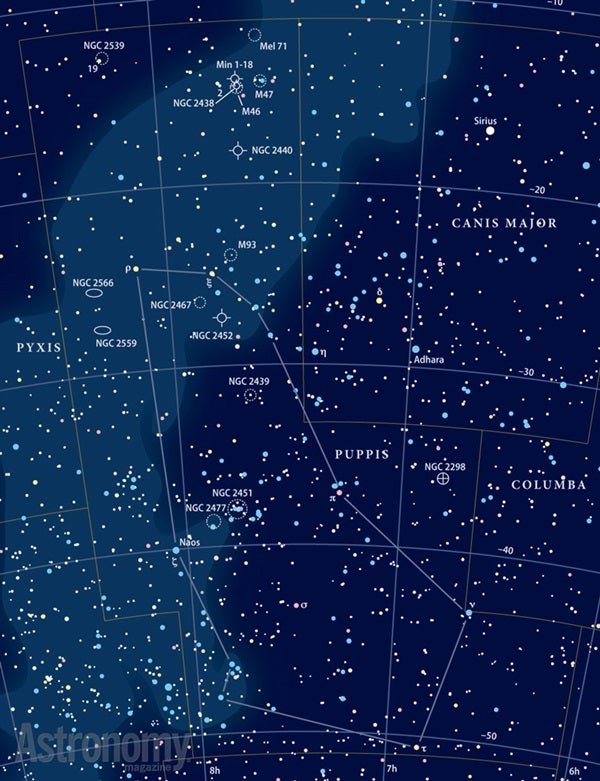Targets for February 6–13, 2014
Binoculars: The Stinging Scorpion (NGC 2451)
Small telescope: Open cluster (M93)
Large telescope: The Albino Butterfly (NGC 2440)
This week’s naked-eye/binocular object is the Stinging Scorpion, an open cluster also known as NGC 2451. It lies in the constellation Puppis the Stern, which lies to the east and south of Canis Major the Great Dog.
To find this object, look 4.1° west-northwest of magnitude 2.2 Naos (Zeta [ζ] Puppis). That’s where you’ll find the Stinging Scorpion. At magnitude 2.8, it’s one of the sky’s brightest apparent open clusters. I say “apparent” because astronomers have plotted the motions of the individual stars here, and they are not traveling through space together. Still, it’s a nice target that’s so bright you can even spot it without optical aid from locations with low levels of light pollution.
NGC 2451 also is huge. At 45′ across, it covers twice as much area as the Full Moon. Binoculars with a magnification of 15x really bring out the best in this object. When you switch to your telescope, use a low-power eyepiece. You’ll see 15 bright stars around orange, magnitude 3.6 SAO 198398, which sits dead center.
Astronomy magazine Contributing Editor Stephen James O’Meara bestowed the common, although little-used, name on this object. He said it appears to him like a scorpion approaching head-on with two outstretched claws and an upright tail ready to sting.
Look for the arrowhead
This week’s small telescope target comes straight from French comet-hunter Charles Messier’s catalog. It’s open cluster M93 in Puppis, also known as NGC 2447.
It lies 1.5° northwest of magnitude 3.3 Xi (ξ) Puppis. Odds are that you may be able to glimpse M93 without optical aid from a dark site. It shines at magnitude 6.2, a brightness well within reach of most amateur astronomers’ eyes if no clouds or light pollution are visible.
With a diameter of 22′, M93 covers half as much area as the Full Moon. Through a 4-inch telescope at 100x, you’ll see an arrowhead shape formed by the cluster’s 30 brightest stars pointing toward the southwest. A haze of unresolved points hover in the background. An 8-inch scope adds about two dozen more stars around the arrowhead.
A southern butterfly
This week’s large telescope target completes my triple play in Puppis and is a planetary nebula called the Albino Butterfly. It also carries the designation NGC 2440.
You’ll find it by pointing your telescope 8.5° northwest of magnitude 2.8 Rho (ρ) Puppis, or a little more than 3° south of open cluster M46. The Albino Butterfly lies some 3,500 light-years from Earth. It glows at magnitude 9.4 and measures 14″ across.
A 4-inch telescope shows NGC 2440 as an oval disk oriented northwest to southeast with a high surface brightness. Because it is so bright, you can use high magnifications on it. But this is an object best viewed through large apertures.
An 11-inch scope at 300x will help you begin to resolve two lobes, with the northeastern one appearing brighter. A faint haze surrounds the bright inner disk. On nights of excellent seeing, push the magnification past 500x to really pull out the details.
Don’t confuse this planetary with Minkowski’s Butterfly, which has the designation M2-9. The Albino Butterfly got its moniker quite naturally. Many planetary nebulae assume a butterfly, or hourglass, shape as they form. This one’s white, so that solves the mystery of its name.
Expand your observing at Astronomy.com
StarDome
Check out Astronomy.com’s interactive StarDome to see an accurate map of your sky. This tool will help you locate this week’s targets.
The Sky this Week
Get a daily digest of celestial events coming soon to a sky near you.
Observing Talk
After you listen to the podcast and try to find the objects, be sure to share your observing experience with us by leaving a comment at the blog or in the Reader Forums.











